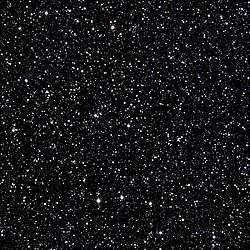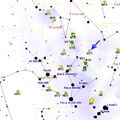Messier 23
Messier 23, also known as NGC 6494, is an open cluster of stars in the southern constellation of Sagittarius.[7] It was discovered by Charles Messier on June 20, 1764.[3] M23 can be found with binoculars or a modestly sized telescope.[3] The cluster is positioned in front of "an extensive gas and dust network", although it is unclear if there is an association between the two.[4] It is located near the ecliptic and thus is subject to lunar occultations.[8]
| Messier 23 | |
|---|---|
 2MASS Atlas image | |
| Observation data (J2000 epoch) | |
| Constellation | Sagittarius |
| Right ascension | 17h 57m 04s[1] |
| Declination | −18° 59′ 06″ |
| Distance | 2,050 ly (628 pc)[2] |
| Apparent magnitude (V) | 5.5[3] |
| Apparent dimensions (V) | 35′[2] |
| Physical characteristics | |
| Mass | 1,206[4] M☉ |
| Radius | 8 ly |
| Estimated age | 330±100 myr[5] |
| Other designations | M23, NGC 6494,[6] Cr 356, C 1753-190 |
The cluster is located 2,050 light years away. Estimates for the number of cluster members range from 169[9] up to 414, with a directly-counted mass of 1,206 M☉; 1,332 M☉ by application of the virial theorem.[4] The cluster is around 330 million years old with a near-solar metallicity of [Fe/H] = −0.04.[5] The brightest component (lucida) is of magnitude 9.3.[10] Five of the cluster members are candidate red giants,[11] while the variable VV Sgr is a candidate asymptotic giant branch star.[12]
Gallery
 Map showing the location of M23
Map showing the location of M23
References
- Wu, Zhen-Yu; et al. (November 2009), "The orbits of open clusters in the Galaxy", Monthly Notices of the Royal Astronomical Society, 399 (4): 2146–2164, arXiv:0909.3737, Bibcode:2009MNRAS.399.2146W, doi:10.1111/j.1365-2966.2009.15416.x.
- Kharchenko, N. V.; et al. (2005), "Astrophysical parameters of Galactic open clusters", Astronomy and Astrophysics, 438 (3): 1163–1173, arXiv:astro-ph/0501674, Bibcode:2005A&A...438.1163K, doi:10.1051/0004-6361:20042523.
- Thompson, Robert; Thompson, Barbara (2007), Illustrated Guide to Astronomical Wonders: From Novice to Master Observer, DIY science, O'Reilly Media, Inc., p. 408, ISBN 978-0596526856
- McNamara, B. J.; Sanders, W. L. (February 1983), "A virial mass determination of the open cluster NGC 6494", Astronomy and Astrophysics, 118 (2): 361–362, Bibcode:1983A&A...118..361M.
- Netopil, M.; Paunzen, E.; Heiter, U.; Soubiran, C. (2016), "On the metallicity of open clusters. III. Homogenised sample", Astronomy & Astrophysics, 585: A150, arXiv:1511.08884, Bibcode:2016A&A...585A.150N, doi:10.1051/0004-6361/201526370.
- "M 23". SIMBAD. Centre de données astronomiques de Strasbourg. Retrieved November 12, 2018.
- Gilmour, Jess K. (2003), The Practical Astronomer's Deep-sky Companion, The Patrick Moore Practical Astronomy Series, Springer Science & Business Media, p. 121, ISBN 978-1852334741.
- Ridgway, S. T.; et al. (February 1979), "Twenty-eight angular diameters for late-type stars by the lunar occultation technique", Astronomical Journal, 84: 247–256, Bibcode:1979AJ.....84..247R, doi:10.1086/112414. See VV Sgr.
- Sanders, W. L.; Schroeder, R. (August 1980), "Membership in the open cluster NGC 6494", Astronomy and Astrophysics, 88: 102–107, Bibcode:1980A&A....88..102S.
- Sanders, W. L. (September 1990), "UBV photometry of NGC 6494 and metallicity considerations", Astronomy and Astrophysics Supplement Series, 84 (3): 615–618, Bibcode:1990A&AS...84..615S.
- Claria, J. J.; Lapasset, E. (November 15, 1989), "Multicolour photometry of red giants in three southern open clusters", Monthly Notices of the Royal Astronomical Society, 241 (2): 301–310, Bibcode:1989MNRAS.241..301C, doi:10.1093/mnras/241.2.301
- Jura, M. (February 1987), "Mass-losing red giants in open clusters", Astrophysical Journal, Part 1, 313: 743–749, Bibcode:1987ApJ...313..743J, doi:10.1086/165012.
External links
| Wikimedia Commons has media related to Messier 23. |
- Messier 23, SEDS Messier pages
- Messier 23 on WikiSky: DSS2, SDSS, GALEX, IRAS, Hydrogen α, X-Ray, Astrophoto, Sky Map, Articles and images
